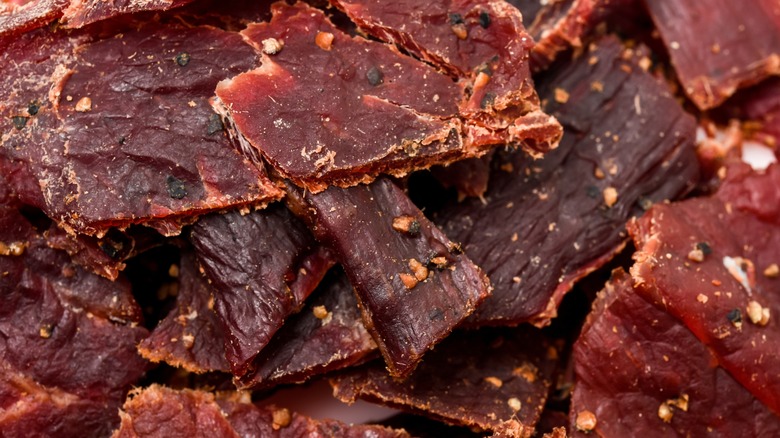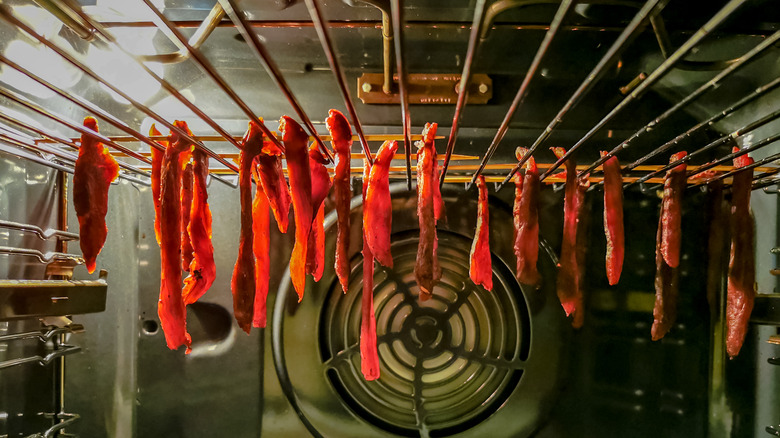Yes, You Can Make Beef Jerky In The Oven
If necessity is the mother of invention, we certainly have her to thank for the savory snack that is beef jerky. The term "jerky" most likely comes from the Incan word "ch'arki," which simply means "dried meat." Hundreds of years later, we're still enjoying jerky as a tasty road trip snack or easy protein while camping. Though store-bought beef jerky can be pretty expensive, it's fairly easy and cost-effective to make in your oven at home — no special equipment required.
Using your oven for homemade beef jerky not only makes this snack even more cost-effective, it also simplifies the process. There's no need to purchase or learn how to use a dehydrator or smoker — instead, you can just prep the beef and pop it in the oven to cure. Ovens are also built to maintain a steady temperature with little to no monitoring, which isn't always true for dehydrators and smokers.
Of course, whenever you're heating anything for a long period of time, certain safety protocols are crucial. You should never leave a heat source unattended while it's turned on, so plan to make your jerky on a day when you'll be at home. It's also best to start your jerky early in the day, so you're awake and ready to handle anything that goes wrong. Additionally, most meat drips a bit as it dries out, so be sure to line your oven with tin foil to prevent liquid from getting on the heating element.
Prepping your beef — flavors, marinades, and how to slice it
A huge perk when making beef jerky at home is that you can customize it to your personal preferences and dietary needs. Store-bought varieties are usually very high in sodium, and while salt can aid the drying process, homemade versions typically still require less than the commercial variety. You can also experiment with a wide array of flavors, from earthy, zesty Chinese five-spice to garlic and lime or smoked paprika and honey.
You'll also need a liquid to complement your flavors and complete your marinade. Worcestershire and soy sauce are popular because of their intense flavors and high salt content, but ordinary cola tenderizes beef beautifully and works well with spicy, garlicky, and citrus marinade ingredients. You'll need about ½ cup of liquid for each pound of meat, so 2 cups for 4 pounds or 1 cup for 2 pounds, etc. Whisk everything together in a bowl so the flavors can blend while you prep your meat.
Of course, the best beef jerky starts with the right cut of meat. Top round (a.k.a. London broil) is popular because it's tender with a deep, beefy flavor. For best results, slice your top round against the grain, meaning perpendicular to the striations in the meat, into ⅛-inch thick slices. This will give the finished product a more tender bite. Once your meat is sliced, let it marinade in the fridge for 2 to 24 hours.
Drying beef jerky in your oven
Once your meat has marinated to your preference, remove it from the fridge and lay the strips of meat on a thick layer of paper towels to help absorb excess moisture. Preheat your oven to about 175 degrees Fahrenheit while you prep your beef to dry. You can either lay the marinated slices flat on wire racks meant for baking, or hang them from the metal racks inside your oven.
To dry your beef flat, line several baking sheets with parchment paper or tin foil. Place a wire rack for baking on top of each sheet, and lay your beef strips in a single layer on each baking rack. To hang your beef from the oven racks, skewer one end of each slice with a wooden toothpick and lay each toothpick across the wires of your oven rack so that the strips of meat are hanging vertically inside your oven.
Let your beef dry for about 3 hours before checking on it. It should be dry to the touch, but still flexible. If it's beginning to crisp, take it out and let it cool. If it still feels juicy, let it continue to dry in 30 minute increments until it feels ready. Once your jerky has cooled, store it in an airtight container on your counter. It should stay fresh for about two weeks.


